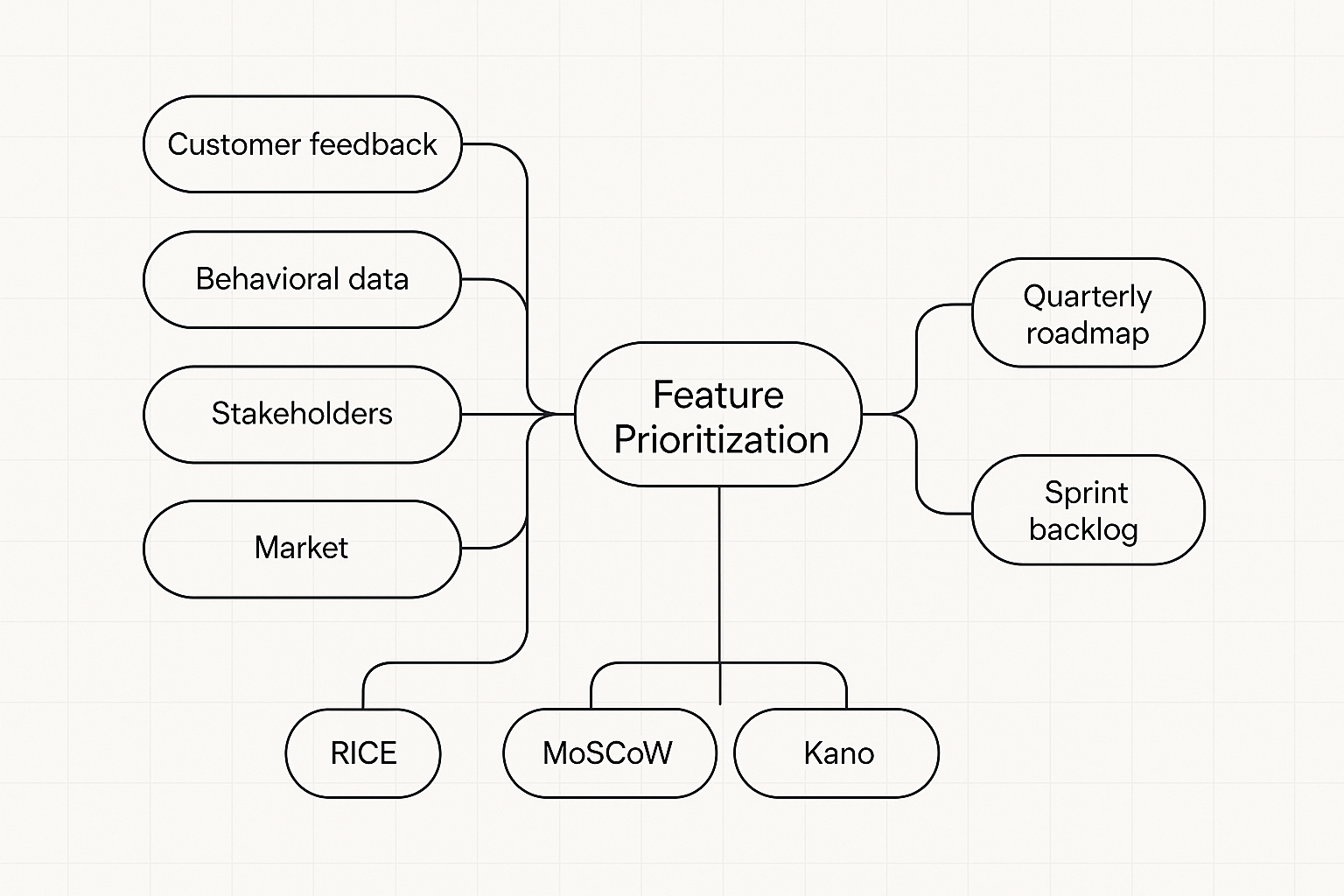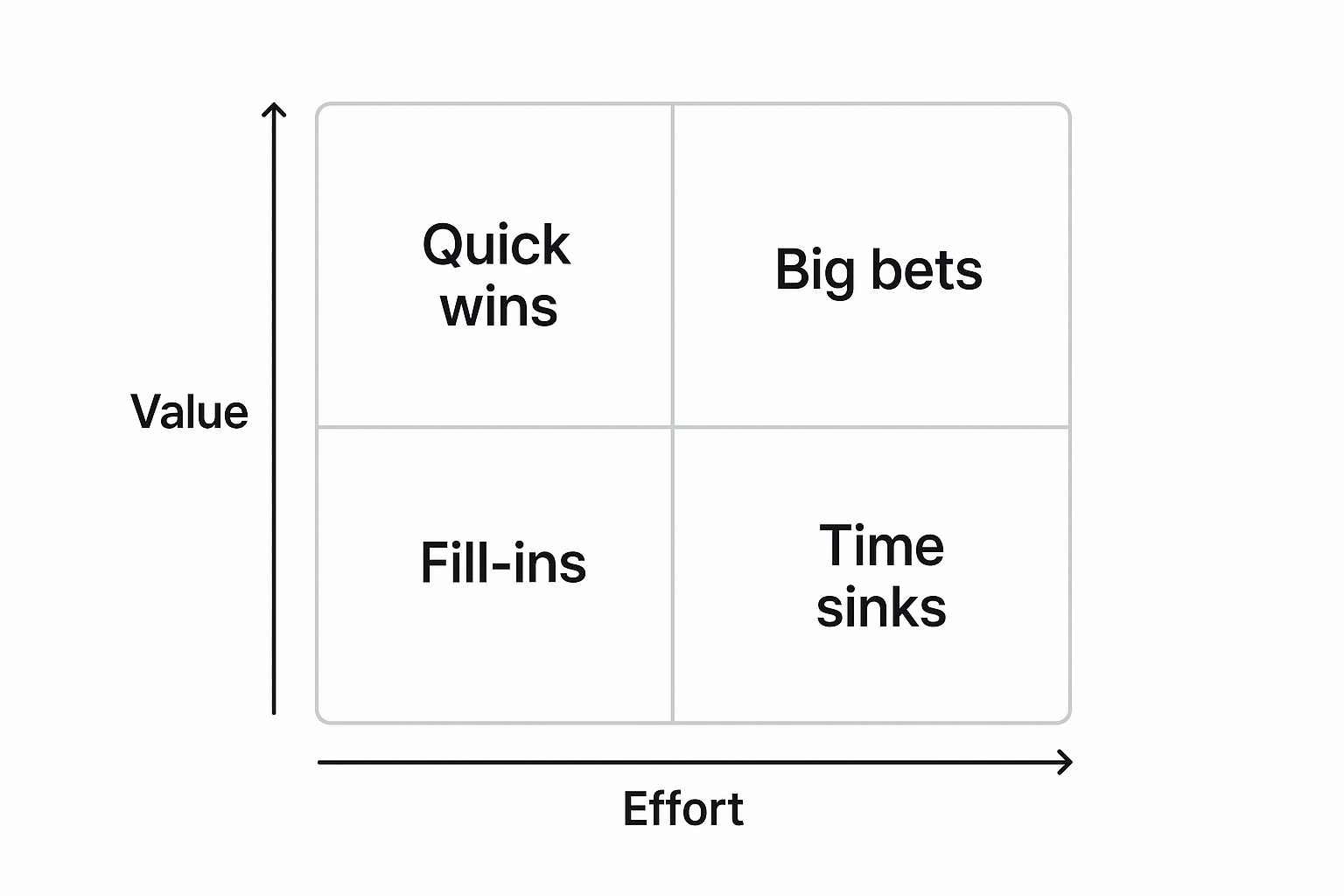Feature prioritization is not a wish list. It is an operating system for product decisions. If you treat feature prioritization as a living process, your product roadmap becomes clearer, your team stays aligned, and customers feel the difference.
# The foundation: make priorities a system, not a sprint
Feature prioritization connects strategy to execution. We compare options by customer value, business impact, effort, and feasibility. Without a clear system, the loudest request wins and the roadmap drifts. A structured approach tightens focus and prevents waste, as outlined in the frameworks overview from The Product Manager (opens new window).
- Goal: deliver the highest value per unit of effort, consistently.
- Cadence: update priorities at least quarterly, faster if your market moves.
- Rule of thumb: no half-finished work shipped. Quality first.

# Gather inputs that matter
Great decisions start with great inputs. We pull from four streams and keep each clean.
- Customer feedback: look for patterns and root causes, not just requests. Session evidence often reveals what customers do not say. See this practical take from FullStory (opens new window).
- Behavioral data: conversion steps, drop-offs, rage clicks. Example: sign-up drop at “Verify email” grew to 38 percent, fix shipped within 7 days, activation up 9 points.
- Stakeholders: sales for objections, support for friction, engineering for feasibility and debt, marketing for positioning. Create rules for intake to avoid the loudest-voice trap.
- Market signals: competitor launches, pricing shifts, new standards. Validate with customers before reacting.
Principle: inputs are raw material, not orders. We use judgment to translate signals into choices.
# The prioritization toolkit, used with intent
No single model fits every decision. We combine frameworks, then cross-check.
- RICE: Reach, Impact, Confidence, Effort. Useful for apples-to-oranges comparisons. See the summary at Atlassian (opens new window). Tip: demand numeric reach estimates, not vibes.
- MoSCoW: Must, Should, Could, Won’t. Great for stakeholder workshops and capacity splits. Keep Must below 60 percent of capacity to leave room for Should and Could.
- Value vs Effort matrix: fast visual sorting into quick wins, big bets, fill-ins, time sinks.
- Kano: separates basics from delighters. Helpful before big UX investments.

How we mix in practice:
- Start with a value vs effort sketch for 20 to 40 candidates.
- Run RICE on the top half to pressure test intuition.
- Tag Kano type for top contenders to avoid investing in delighters while basics lag.
- Use MoSCoW to finalize capacity and communicate trade-offs.
# Define decision criteria that tie to outcomes
Choose 4 to 6 criteria, score consistently, and document rationale.
- Customer impact: activation, retention, NPS change, ticket reduction.
- Business value: revenue lift, conversion, cost savings.
- Confidence: strength of evidence, data quality.
- Effort: scoped in engineer-weeks, with risk ranges.
- Strategic fit: aligns to the current theme or annual bet.
Balance numbers with narrative. Metrics frame the call, your judgment makes it.
# From scores to roadmap, without wishful thinking
Scores inform the plan, they do not dictate it. Dependencies, sequencing, and capacity shape the final cut.
- Map dependencies early. If Feature B requires A, plan the pair as a unit.
- Sequence for learning. Ship a thin slice to validate demand before scaling the solution.
- Protect quality. Example: keep 15 percent of capacity for bug fixes and 10 percent for debt each sprint.
For stakeholder alignment techniques and governance patterns, this guide from Aha! (opens new window) is a solid reference.
# Communication that sticks
Tailor the message, keep the core consistent.
- Executives: two slides, one story, clear trade-offs.
- Engineering: scope, risks, dependencies, ready criteria.
- Sales and CS: problem statements, customer segments, timing, talk tracks.
Be transparent about why items moved up or down. Publish criteria, inputs, and the latest snapshot. Clarity lowers the temperature of hard conversations.
# Keep it living: cadence and feedback loops
Roadmaps age fast. Set a rhythm and measure your calls.
- Cadence: monthly reviews for inputs, quarterly roadmap refresh.
- Signal checks: watch the assumptions behind decisions. If a competitor ships a core capability, reassess within the week. For cadence and triggers, see this playbook from LaunchNotes (opens new window).
- Outcome review: compare predicted impact to actuals. Track misses and why they happened. Adjust weights if your model overvalues certain criteria.
# Common pitfalls and how we avoid them
- Overcommitting capacity: leads to slip and stress. We cap planned work at 80 percent, keep 20 percent for interrupts and learning.
- Data theater: fancy dashboards with weak data. We annotate confidence and call out gaps.
- Loudest voice wins: prevented by published criteria and cross-functional scoring.
- Neglected foundations: UX and tech debt silently tax velocity. Reserve budget every cycle.
For a clear overview of frameworks and when to use them, refer back to The Product Manager (opens new window).
# Quick answers
- What is feature prioritization? A system for ranking work by value, effort, and strategy to build a focused product roadmap.
- How often should I update a roadmap? At least quarterly, faster in volatile markets.
- Which framework is best? None alone. Combine RICE, MoSCoW, and a value vs effort view, then add Kano when shaping UX.
- How do I handle strong executive requests? Score them with the same criteria, show trade-offs, and document the decision.
# Tooling to make it real
Capture feedback, aggregate signals, and keep discussions in one place. If you want a lightweight system to collect, score, and communicate priorities, explore Sleekplan features (opens new window). Centralizing feedback cuts noise and makes your criteria visible.
# Closing thought
Feature prioritization is craft. The details matter, from how you word a problem statement to how you size effort. Build a simple system, keep it honest, and iterate. Your roadmap will feel calmer and ship stronger work.